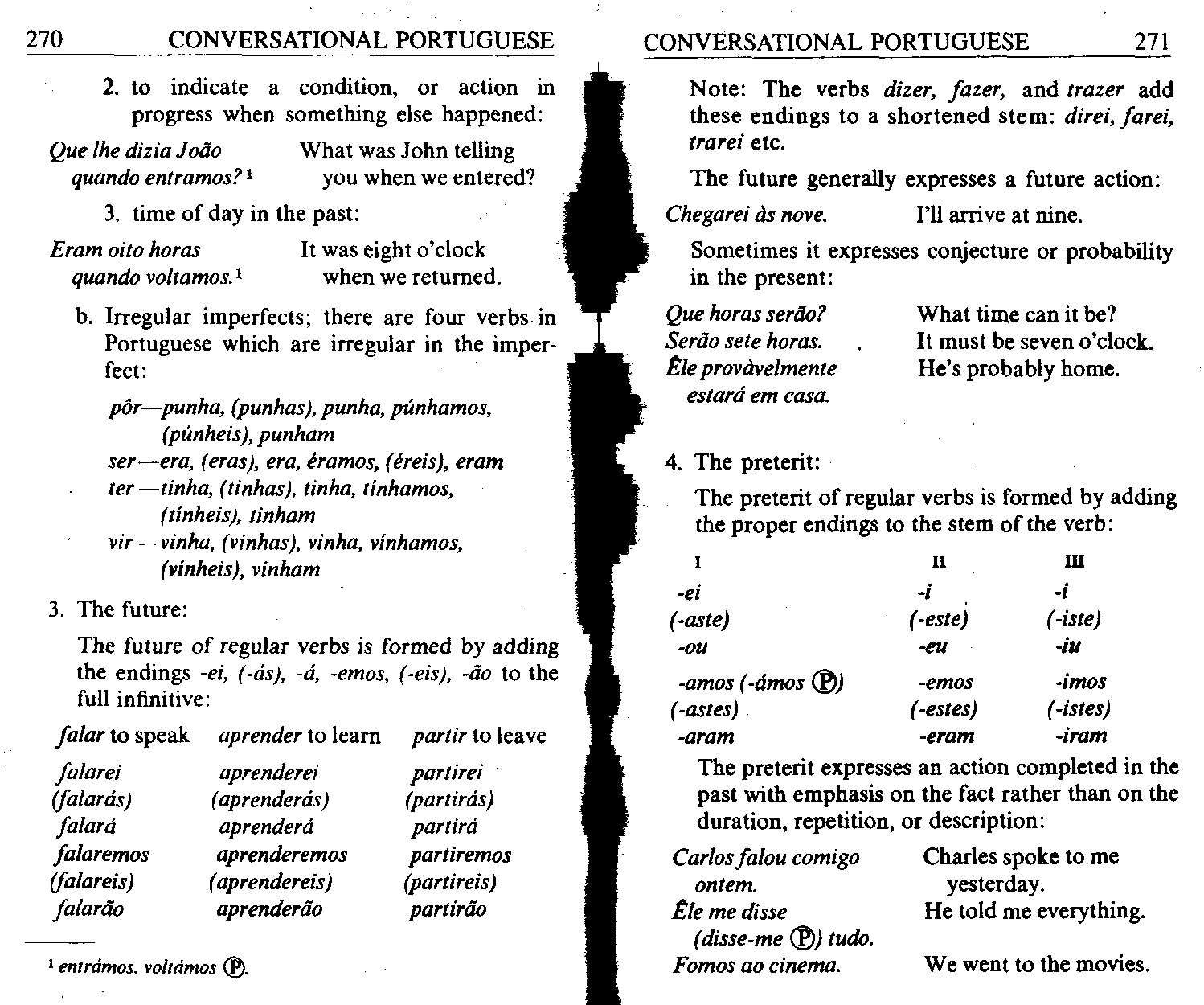Summary p270

270 CONYERSATIONAL PORTUGUESE
2. to indicate a condition, or action in progress when something else happened:
Que łhe dizia Jodo What was John telling
ąuando entramos?1 you when we entered?
3, time of day in the past:
Eram oito horas It was eight o’clock
ąuando voltamos.1 when we retumed.
b. Irregular imperfects; there are four verbs in Portuguese which are irregular in the imper-fect:
pór—punka, (punhas), punka, punhamos, (punheis), punham
ser—era, (eros), era, eramos, (ereis), eram ter—tinha, (tinhas), tinha, tinhamos,
(tinheis), tinham
vir —vinha, (vinhas), vinha, vinhamos,
(vinheis), vinham
3. The futurę:
The futurę of regular verbs is formed by adding the endings -ei, (-ós), -a, -emos, (-eis), -do to the fuli infinitive:
aprender to leam
aprenderei
(aprenderas)
aprendera
aprenderemos
(aprendereis)
aprenderdo
falar to speak
falarei
(fałaras)
falard
falaremos
(falareis)
falarao
partir to leave
partirei
(partiras)
partira
partiremos
(partireis)
partirdo
1 entramos, voltamos 0.
Notę: The verbs dizer, fazer, and trazer add these endings to a shortened stem: direi,/arei, trarei etc.
The futurę generally expresses a futurę action: Chegarei ds nove. 1*11 arrive at nine.
Sometimes it expresses conjecture or probability in the present:
Que horas serdo? What time can it be?
Serdo sete horas. It must be seven o’clock.
źle proyóyelmente He’s probably home.
es tara em casa.
4. The preterit:
The preterit of regular verbs is formed by adding the proper endings to the stem of the verb:
|
I |
il |
Ul |
|
-ei |
-i |
-i |
|
(•as te) |
(•este) |
(-iste) |
|
-ou |
-eu |
iiu |
|
-amos (-dmos |
-emos |
-imos |
|
(-astes) |
(-estes) |
(-istes) |
|
-aram |
-eram |
-iram |
The preterit expresses an action completed in the past with emphasis on the fact rather than on the duration, repetition, or description:
Carlos falou comigo Charles spoke to me
ontem. yesterday.
źle me disse He told me everything.
(disse-me tudo.
We went to the movies.
Fomos ao cinema.
Wyszukiwarka
Podobne podstrony:
Summary p290 290 CONYERSATIONAL PORTUGUESE SER 1. indicates a characteristic or inherent ąuality:
Summary p304 304 CONYERSATIONAL PORTUGUESE Some of the other verbs in -gar: apagar to put out, e
Summary p240 240 CONYERSATIONAL PORTUGUESE 14. THE PLURAL 1. Nouns ending in a vowel, including na
Summary p222 222 CONYERSATIONAL PORTUGUESE 21. Vamos_(to have dinner). a. jantar
Summary p242 242 CONYERSATIONAL PORTUGUESE seu can also be used to translate “his,” “her,” “their.
Summary p250 250 CONYERSATIONAL PORTUGUESE CONYERSATIONAL PORTUGUESE_ 251 (te) I
Summary p258 258 CONYERSATIONAL PORTUGUESE 23. ADYERBS 1. Some Portuguese adverbs are formed by ad
Summary p268 268 CONYERSATIONAL PORTUGUESE 2. The personal infinitiye has endings which make it ea
Summary p284 284 CONYERSATIONAL PORTUGUESE finał a changed to e and finał e changed to a (but also
Summary p288 288 CONYERSATIONAL PORTUGUESE Although both forms are used, therc is a tend-ency for
Summary p300 300 CONYERSATIONAL PORTUGUESE cated, the change given will pertain to those forms of
Summary p306 306 CONYERSATIONAL PORTUGUESE 7. Verbs ending in -guer ot -guir In these verbs gu cha
Summary p310 310 CONYERSATIONAL PORTUGUESE Eleger to elect 1. PAST. PART.! elegido and eleito
Summary p224 224 CONYERSATIONAL PORTUGUESE (3) variations occur in different areas: a.
Summary p226 226 CONYERSATIONAL PORTUGUESH CONYERSATIONAL PORTUGUESE 227 d g g h j I I Ut m as d i
Summary p230 230 CONYERSATIONAL PORTUGUESE 3, The cedilla (cedilha) is used with
Summary p234 234 CONYERSATIONAL PORTUGUESE k. with parts of the body and articles of clothing inst
Summary p236 236 CONYERSATIONAL PORTUGUESE De and em combine with the demonstrative forms (see GS2
Summary p238 238 CONYERSATIONAL PORTUGUESE 13. MASCULINE AND FEMININE 238 CONYERSATIONAL PORTUGUES
więcej podobnych podstron